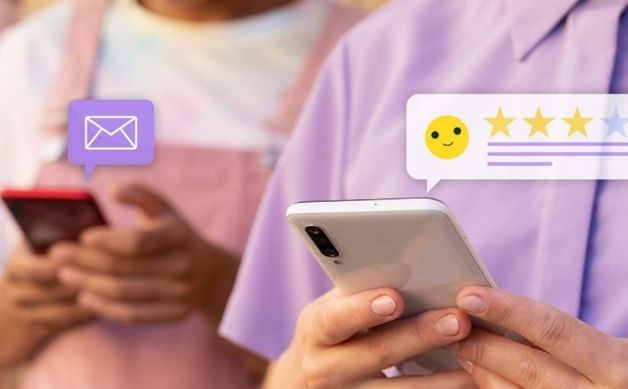Discover how omnichannel communication can create personalized experiences
Studies suggest that 73% of people reported they now spend more time buying online than they ever have before. Which means, your target audience is always immersed in their digital devices.
The paradigm shift has irrevocably altered the world of commerce. While many customers were already purchasing across many digital platforms and touchpoints, COVID-19 has effectively pushed them to rely more on the accessibility, convenience, and ease of use that digital shopping and e-commerce offer.
Here’s how to revisit your Customer Experience Strategy post COVID-19
Your business must be prepared to engage your audience with an omnichannel approach across all touchpoints as customers begin to explore and shop with brands on an increasing number of digital channels. While executing an omnichannel strategy successfully may have been a massive endeavor in the past, contemporary omnichannel data show that such a strategy is not only helpful but also necessary.
What does omnichannel mean?
Omnichannel is a customer experience strategy that ensures seamless engagement with your customers across all points of contact so they can be well connected and engaged with your brands.
Earlier, many businesses and retailers relied on either single-channel or multi-channel engagements. Across industries, there has been a move from traditional channels to an omnichannel customer service strategy. The key reason behind this paradigm shift is to deliver a seamless support experience irrespective of the medium a customer chooses to interact with a business. This could include multiple channels, including email, website, direct calls, social media, self-service, live chats, etc., to name a few.
Maximize your support capabilities with an omnichannel approach
The modern consumer expects everything to be available immediately and at their leisure. And, because of this shifting customer demand, your company must have an omnichannel customer service plan to keep your consumers happy. Additionally, satisfied consumers are more likely to recommend your company to their peers, resulting in a higher customer lifetime value.
How to create an omnichannel personalization strategy
You can customize your strategy by asking the right set of questions and scrutinizing the insights derived from them.
- Who are the key customers?
- Which customers have the highest lifetime value?
- At which stage of the purchase journey are customers most likely to abandon the process?
- What platforms are the customers’ most preferred segment?
You will be better positioned to understand which channels to scale your personalization efforts on once you examine the insights collected from the above.
Below are a few pointers that highlight the best way to create an omnichannel strategy for personalized experiences:
1. Define a streamlined communication strategy
At its core, omnichannel experience necessitates the implementation of a unified communication strategy. Though personalization will always be important when dealing with consumers, having a few simplified responses on hand will save you time and help you provide a better customer experience.
2. Create a customer journey map
Understanding a customer’s journey from first learning about a product or service to becoming a loyal customer is critical to developing a successful cross-channel strategy. Customer mapping is a step that comprises the following:
- Creating buyer personas and properly segmenting clients to ensure that their wants and expectations are met
- Identifying each drop-off area and channel pain points
- Determining the most effective ways and channels for re-engaging potential and current consumers
Not only will mapping your client’s journey helps you uncover pain points, but it will also highlight the opportunities for improving and enhancing customer experience. You can better understand the requirements and concerns of your current and potential clients by doing so. It also allows your business to increase client satisfaction.
3. Build a reliable brand
Customers are more inclined to trust you as a brand if they receive the same experience and attention to their needs regardless of how they connect with you. This establishes your company as dependable, allowing you to keep consumers for a longer amount of time. Unified messaging across all channels, whether it is your support services or your overall brand communication, aids in the development of a stronger brand identity and increases brand recall value dramatically.
Benefits of omnichannel support
Here are the key benefits of omnichannel customer experience service and how it enhances your customer’s relationship with your brand:
1. Customized experience
Omnichannel customer support makes life easier for customers by providing them with multiple paths to engage with your brand. Omnichannel support not only provides convenience to the customer but also ensures that they have an exceptional experience every time. Customer engagement channels such as chat, forums, and webinars can give you an outline of your customers’ past and present interactions. You can obtain a sense of how your consumers’ needs vary across multiple channels by placing these streams of data in a broader context, allowing you to alter operations and serve them better.
2. Establish customer loyalty
Customers today have a variety of options when it comes to finding the required information about the products and services of their choosing. Product specifications and pricing information are now easily available and accessible at the click of a button. As a result, it is not difficult for a potential customer to choose your competitors over you.
However, let us look at the most common metrics used to quantify customer loyalty:
- Whether the customer will recommend your company to their peers, or
- Whether the customer will return to your store in the future.
Omnichannel Support – The future of customer experience
You have a good chance of gaining consumer loyalty if you use an omnichannel company strategy. When your sales and customer service reps can communicate with customers on any channel and access their historic data easily, they will be better at providing assistance. Conversely, this will allow your customers to switch channels on the fly and therefore enrich their experience with flexibility and convenience.
3. Boost sales
An omnichannel customer strategy aids in client retention for a longer period, and loyal customers are more inclined to return to your business. An omnichannel retail strategy enhances the consumer experience by offering a variety of venues for customer purchases, including in-store, online, and mobile. An amazing, pleasant customer experience will set you apart from your competition, allowing you to better analyze them and enhance your revenue.
In a nutshell
An omnichannel customer experience means putting your customers first. You can provide your customers with an exceptional customer journey across channels and offer them complete leverage – no matter where, when, and how, as per their leisure. Companies that adopt an omnichannel customer strategy and leverage digital customer experience are well-positioned to move ahead of their competition.
In fact, companies that have been able to tailor the customer experience across multiple channels have been reported to improve revenue by 5-15% over their entire customer base. Customers are willing to spend 48% more money when their experience is personalized, therefore this trend of omnichannel personalization being used to maximize customer experiences is incredibly crucial for your success.










